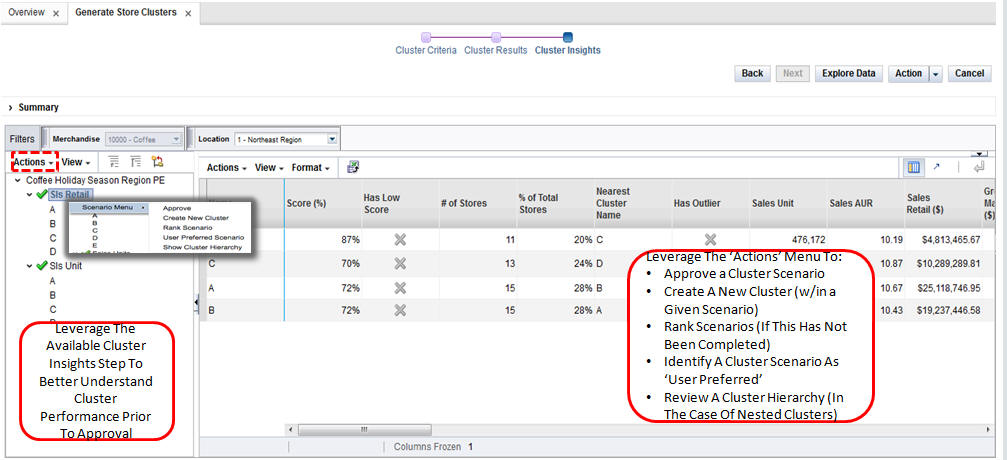Insights Stage
Use the Insights stage to analyze a scenario, its clusters, and its hierarchy, based on performance and attribute contributions, prior to the approval of the scenario. This stage includes the following tasks:
-
Approve a cluster scenario
-
Create a new cluster within a scenario
-
Rename clusters within a scenario
-
Rank scenarios, if not completed earlier
-
Flag a cluster scenario as "system preferred"
-
Review a cluster hierarchy in a nested cluster
Select from the following views in this stage:
-
Criteria view. Displays the parent cluster, if it exists, or the scenario for root-level clusters.
-
Parent cluster. Displays any child clusters.
-
Cluster. Displays the stores under the selected cluster.
Each cluster is identified by the following information:
Table 4-22 Insights Stage
| Field Name | Description |
|---|---|
|
Name |
The name assigned to the cluster. |
|
Nearest Cluster Name |
The name of the cluster that is most similar to the named cluster. |
|
# of Stores |
The number of stores in the cluster. |
|
Is Outlier |
Whether or not the cluster is considered an outlier. If it is an outlier, you may want to review that store. |
|
All Sales Metric |
Financial information about the store. |
|
Score % |
This value is calculated at the level of store and then averaged to the cluster. The probability, expressed as a percent, of a store being present in this cluster rather than any of the other clusters. |
|
Has Low Store |
Indicates a cluster that falls below a defined threshold. |
|
% Total Stores |
The percentage of the total stores that the number of stores represents. |
|
Sales Retail |
The sales revenue for the cluster or store. The merchandise and the source time period are selected when the cluster parameters are set up. |
|
Sales Unit |
The sales units for the cluster or store. The merchandise and the source time period are selected when the cluster parameters are set up. |
|
Sales Average Unit Retail |
The average unit retail sales for the cluster or store. The merchandise and the source time period are selected when the cluster parameters are set up. |
|
Gross Margin Retail |
The retail sales minus the cost of goods sold for the cluster or store. The merchandise and the source time period are selected when the cluster parameters are set up. |
|
Gross Margin Percent |
The retail sales minus the cost of goods sold divided by the retail sales for the cluster or store. The merchandise and the source time period are selected when the cluster parameters are set up. |
|
Cluster Centers |
Additional attributes for each cluster. |
You use this stage to view all scenarios, examine and compare sales metrics for the various clusters, and manage clusters by approving, rejecting, merging, or deleting clusters.
